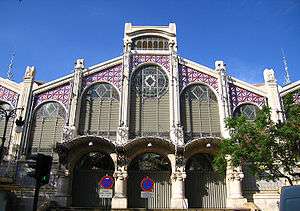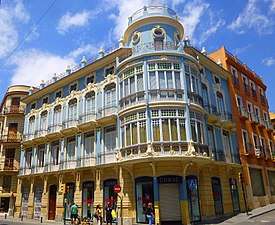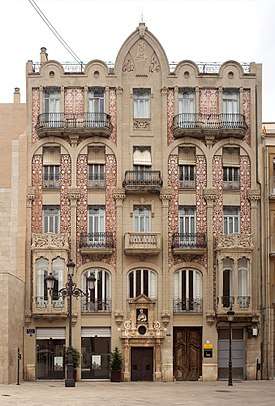Valencian Art Nouveau







.jpg)
Valencian Art Nouveau (Spanish for modernismo valenciano, Valencian modernisme valencià), is the historiographic denomination given to an art and literature movement associated with the Art Nouveau in the Valencian Community, in Spain.
Its main form of expression was in architecture, but many other arts were involved (painting, sculpture, etc.), and especially the design and the decorative arts (cabinetmaking, carpentry, forged iron, ceramic tiles, ceramics, etc.), which were particularly important, especially in their role as support to architecture.
Although Art Nouveau was part of a general trend that emerged in Europe around the turn of the 20th century, in the Valencian Community the trend acquired its own unique personality in the context of spectacular urban and industrial development. It is equivalent to a number of other fin de siècle art movements going by the names of Art Nouveau in France and Belgium, Jugendstil in Germany, Sezession in Austria-Hungary, Liberty style in Italy and Modern or Glasgow Style in Scotland.
The Valencian Art Nouveau was active in the Valencian Community from roughly 1899 (art nouveau reform of the Glorieta Park in Alcoy) to 1917. The Modernisme movement in the Valencian Community is best known for its architectural expression, especially in the works of the architects Demetrio Ribes Marco and Francisco Mora Berenguer in Valencia or Vicente Pascual Pastor and Timoteo Briet Montaud in Alcoy, but was also significant in sculpture and painting. Notable art nouveau painters include Fernando Cabrera Cantó, Francisco Laporta Valor, Emilio Sala, Adolfo Morrió and Edmundo Jordá. A notable art nouveau sculptor was Lorenzo Ridaura Gosálbez.
On the other hand, there are several Valencian populations who form part of the Art Nouveau European Route,[1]an association of local governments and non-governmental institutions for the international promotion and protection of Art Nouveau heritage. It is the case of Alcoy,[2]Novelda[3]and Sueca.[4]
Architecture
Early 20th century architecture in Valencian Community was strongly influenced by European Art Nouveau. The Valencian Art Nouveau takes place in different cities or areas, inside of a context of great industrial, economic and urban development: Alcoy and Valencia, by number of works, will be the main Valencian cities where much more was developed the art nouveau architecture. Novelda, Alicante, Burriana, Castellón de la Plana or Sueca are other cities with important examples of Valencian Art Nouveau architecture.
With Valencian local architects, all of them formed in Barcelona or Madrid and contemporaries to the Catalan Modernism and to the Art Nouveau of Madrid, but that exercised the main part of his career in the Valencian Community, the Valencian Art Nouveau will receive a special architectural relevancy in different Valencian cities.[5]
The Mercado Central (English: Central Market) in Valencia, one of the largest in Europe, covers more than 8,000 square metres, over two floors, with a predominantly Valencian Art Nouveau style. Its unusual roof comprises original domes and sloping sections at different heights, while the interior seems to be lined in a range of materials such as iron, wood, ceramics and polychromed tiles. The beauty of the building stands out especially on account of the light that enters through the roof at various points, and through coloured window panels.[6]
The Estación del Norte (English: North Station) is the main railway station in Valencia located in the city centre next to the Plaza de Toros de Valencia. It was declared Good of Cultural Heritage in 1987.
The Mercado de Colón (English: Columbus Market) is a public market located in the city center of Valencia. The building was designed by the Valencian architect Francisco Mora Berenguer between 1914 and 1916. This is a clear example of Valencian Art Nouveau architecture of the early century. It was declared a national monument. It impresses with its extraordinary facade and lavish decor.[7]
Main buildings of the Valencian Art Nouveau
Between the works of the Valencian modernisme stand out:
Province of Alicante
- Casa del Pavo, work of Vicente Pascual Pastor, (1909).
- Casa d'Escaló, work of Vicente Pascual Pastor, (1906-1908).
- Circulo Industrial de Alcoy, work of Timoteo Briet Montaud, (1909-1911).
- Casa Laporta, work of Timoteo Briet Montaud, (1904)
- Campus of Alcoy of the Technical University of Valencia, work of Vicente Pascual Pastor.
- Casa Vilaplana, work of Vicente Pascual Pastor, (1906).
- Casa Briet, work of Timoteo Briet Montaud, (1910).
- Hydroelectrics substation of Alcoy, work of Timoteo Briet Montaud, (1910).
- Canalejas Viaduct
- Monte de Piedad y Caja de Ahorros de Alcoy
- Casa Mataix
- Edificio en calle Sant Llorenç 3
- Edificio en calle Sant Llorenç 5
- Edificio en calle Sant Llorenç 27
- Edificio en calle Sant Nicolau 4
- Edificio en calle Sant Nicolau 29
- Edificio en calle Sant Nicolau 35
- Cocheras en plaza Emili Sala 12
- Edificio en avenida País Valencià 30
- Edificio en calle Capellà Belloch 9
- Edificio en calle Sant Josep 26
- Edificios en calle Pintor Casanova 16, 18 y 20
- Edificios en calle Bartolomé José Gallardo 1, 3 y 5
- La Glorieta de Alcoy
- Fábricas en calle Sant Joan 43 y 45
- Edificio del Parque de Bomberos
- Taller de carruajes en calle Agres 5
- Fábrica en calle Agres 8
- Fábrica en calle Alcoleja 4
- Matadero municipal de Alcoy
- Fuente de El Molinar de Alcoy
- Alcoy Cemetery, Art nouveau pantheons and sculptures.
- Mercado Central de Alicante
- Casa Carbonell
- Casa del Ascensor
- Edificio Torrent
- Casa Campos Carrera
- Casa de las Brujas
- Santuario de Santa María Magdalena
- Art Nouveau House-Museum, work of Pedro Cerdán (1900-1904).
- Centro Cultural Gómez-Tortosa
- Casa Mira
- Casa Villaescusa
- Teatro Circo
- Lonja de Orihuela
- Plaza Nueva
- Centro Cultural Miguel Hernández
- Templete de Música
- Casa de San Gregorio
- Casa Raimundo
- Edificio clínica de los Santos Médicos
- Chapí Theatre
Province of Castellón
- Casa Bosch
- Orange Museum
- Circulo Frutero Burrianense
- Edificio de Correos de Castellón
- Edificio de Les Cigonyes
- Edificio Academia la Purísima
- Edificio Dávalos
- Transformador de Viuda de Estela
- Casa Giner
- Casa Sendra
Province of Valencia
- Almacén de los hermanos Peris Puig
- Almacén de José Ribera
- Palacete París
- Teatro Serrano
- Asilo de ancianos de Sueca
- Ateneo Suecano del Socorro
- North Station
- Central Market of Valencia
- Mercado de Colón
- Light fountain of the Exposición Regional Valenciana
- Bridge of the Exposición Regional Valenciana 1909
- Edificio de Correos
- Palacio de la Exposición de Valencia
- Hospital asilo de San Juan de Dios
- Edificio Ferrer
- Casa del Punto de Gancho
- Edificio Monforte
- Edificio Sánchez de León
- Casa de los Dragones
- Casa Ordeig
- Casa Ortega
- Edificio Chapa
- Edificio Gómez I
- Edificio Gómez II
- Edificio Grau
- Palacete de Ayora
- Edificio Francisco Sancho
- Edificio Suay
- Casa Noguera
- Casa Tarín
- Casa Boldún
- Hotel Reina Victoria
- Casa Peris
- Edificio Aznar
- Edificio Bolinches
- Hotel Palace
- Casa de las Golondrinas
- Edificio Cortina
- Casa de Salvador Llop
- Edificio Olympia
- Industria Lanera Valenciana
- Edificio de Tabacalera
- Balneario de la Alameda
- Convento de Santa Clara
- Central Eléctrica de Nou Moles
- Cinematógrafos Caro
- Tinglados del Puerto de Valencia
- Edificio del Reloj
- Casa-Museo de Blasco Ibáñez, etc.
- Edificio Botella
Valencian Art Nouveau architects
The main architects of the Valencian Art Nouveau movement by each city are:
Province of Alicante
- Alcoy: Vicente Pascual Pastor, Timoteo Briet Montaud, etc.
- Alicante: Francisco Fajardo Guardiola, Juan Vidal Ramos and Enrique Sánchez Sedeño.
- Novelda: José Sala Sala and Pedro Cerdán.
- Orihuela: Severiano Sánchez Ballesta.
Province of Castellón
- Castellón de la Plana: Demetrio Ribes Marco, Godofredo Ros de Ursinos and José Gimeno Almela.
Province of Valencia
- Alzira: Emilio Ferrer Gisbert
- Gandia: Víctor Beltrí
- Sueca: Buenaventura Ferrando Castells
- Valencia: Francisco Mora Berenguer, Demetrio Ribes Marco, José María Manuel Cortina Pérez, Antonio Martorell Trilles, Vicente Ferrer Pérez, Emilio Ferrer Gisbert, Pelegrín Mustieles Cano, Manuel Peris Ferrando, Alexandre Soler, Francesc Guàrdia i Vial, Enrique Viedma Vidal, Manuel García Sierra, Vicente Rodríguez Martín, Ramón Lucini Callejo, Luis Ferreres Soler, Vicente Sancho Fuster, Carlos Carbonell Pañella, Lucas García Cardona, Francisco Almenar Quinzá, etc.
See also
References
- ↑ Art Nouveau European Route: Cities
- ↑ Alcoy in tbe Art Nouveau European Route
- ↑ Novelda in tbe Art Nouveau European Route
- ↑ Sueca in tbe Art Nouveau European Route
- ↑ "La Valencia modernista". Las Provincias. july 10th 2014.
- ↑ Central Market of Valencia Turespaña, Spain National Tourism Agency.
- ↑ Official website of the Mercado de Colón
Bibliography
- Benito Goerlich, Daniel (1992). Arquitectura modernista valenciana (in Spanish/Valencian). Valencia: Fundación Bancaja. p. 273. ISBN 8487684157.
- Benito Goerlich, Daniel (2007). Modernisme en l'arquitectura valenciana (in Valencian). Valencia: Generalitat Valenciana. p. 416. ISBN 9788448246679.
- Mestre Martí, María. (2007). La arquitectura del modernismo valenciano en relación con el Jugendstil vienés. 1898-1918. Paralelismos y conexiones.. Universitat Politècnica de València.
- De Soto Arandiga, Concepción. (2012). "Arquitectos y arquitecturas modernistas en la ciudad de Valencia 1900-1915. Valencia ante el modernismo" Real Academia de Cultura Valenciana.
- Colomer Sendra, Vicente (2002). Colegio Oficial de Arquitectos de la Comunidad Valenciana, ed. Registro de Arquitectura del Siglo XX en la Comunidad Valenciana (en castellano/valenciano). p. 719. ISBN 84-87233-38-4.
- Doménech Romá, Jorge (2010). Modernismo en Alcoy, su contexto histórico y los oficios artesanales. Editorial Aguaclara. p. 497. ISBN 978-84-613-8233-0.
- Doménech Romá, Jorge (2013). Del Modernismo al Funcionalismo, características y evolución del movimiento modernista, el modernismo en Alcoy y Novelda (casos concretos). Publicaciones de la Universidad de Alicante. p. 224. ISBN 978-84-9717-267-7.
- Jaén i Urban, Gaspar (1999). Instituto de Cultura Juan Gil-Albert, Colegio Territorial de Arquitectos de Alicante, ed. Guía de arquitectura de la provincia de Alicante. p. 311. ISBN 84-7784-353-8.
External links
| Wikimedia Commons has media related to Valencian Art Nouveau. |
